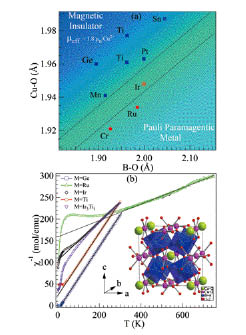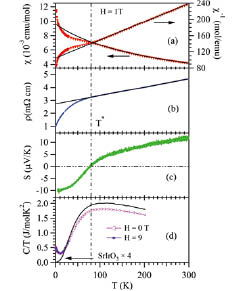Possible Kondo Physics Near a Metal-Insulator Crossover in the A-site Ordered Perovskite CaCu3Ir4O12
Uwatoko Group
The interplay between localized and itinerant electrons is at the heart of many intriguing phenomena such as the heavy-fermion behavior and the unconventional superconductivity associated with a magnetic quantum critical point [1]. The archetype systems for studying such interplay are concentrated on the 4f/5f-based intermetallic compounds, which can be effectively described as a Kondo lattice consisting of a dense periodic array of f electrons interacting with the conduction-band electrons [2]. Here, we reported the realization of an analog d-electron Kondo lattice in a novel A-site-ordered perovskite CaCu3Ir4O12, which can be synthesized only under high-pressure conditions, e.g. at 9 GPa and 1250 °C [3].

Fig. 1. (a) The Cu-O bond length in the coplanar CuO4 versus B-O bond length in the octahedral BO6 for A-site ordered perovskites CaCu3B4O12; (b) The inverse magnetic susceptibility of several CaCu3B4O12 perovskites; inset: schematic crystal structure of the A-site ordered perovskite.

Fig. 2. Temperature dependence of (a) magnetic susceptibility χ(T) and its inverse χ-1(T) measured under H = 1 T after zero-field cooling, (b) resistivity ρ(T) under H = 0 T, (c) thermopower S(T), and (d) specific heat C(T) under H = 0 and 9 T.
As shown in Fig. 1(b), the A-site-ordered perovskite CaCu3B4O12 can accommodate the Cu2+ and the transition-metal B4+ ions, respectively, in the square-planar CuO4 and octahedral BO6 units, in which the d electrons can be coupled by strong covalent mixing with shared O2- ions. Depending on the B4+ ions, the Cu2+ 3d electrons can be tuned to be either localized or itinerant. A plot of Cu-O versus B-O bond length in Fig. 1(a) illustrated that the Cu2+ 3d electronic states in CaCu3Ir4O12 is located right at the itinerant-to-localized boundary. In consistent with this observation, the magnetic susceptibility of CaCu3Ir4O12 shown in Fig. 1(b) demonstrated a crossover from the high-temperature Curie-Weiss (CW) behavior to a low-temperature enhanced Pauli paramagnetism.
Figure 2 summarizes the physical properties of CaCu3Ir4O12. The χ(T) measured at H = 1 T shows no signature of a magnetic ordering transition down to 1.8 K, but a clear deviation from the CW law below T*≈ 80 K. The susceptibility anomaly below T* is echoed in ρ(T), and also in the thermoelectric power S(T). Above T*, ρ(T) follows a perfect linear T-dependence; below T*, ρ(T) exhibits a strong downward trend with no sign of a curvature change down to 0.5 K, strongly suggestive of non-Fermi-liquid behavior. Significantly, S(T) also behaves anomalously, changing sign at T* and remaining large as T approaches zero. The large thermoelectric power at low temperatures signals strongly energy-dependent quasiparticle properties. The absence of a corresponding anomaly in the specific heat C(T) rules out the possibility of a second-order phase transition at T*. Interestingly, C/T of CaCu3Ir4O12 exhibits a remarkable enhancement below ~ 20 K. The absence of a corresponding enhancement in the closely related SrIrO3 perovskite, which is a Pauli paramagnetic metal, indicates that this low-temperature anomaly must be associated with the Cu2+ 3d electrons or with interactions between Cu:3d and Ir:5d.
The presence of a characteristic temperature at T* = 80 K is reminiscent of the low-temperature behavior in typical heavy-Fermion materials, and is suggestive of Kondo-like hybridization between primarily localized Cu2+ 3d electrons and the itinerant Ir 5d electrons below T*. In this picture, electrons on the two sublattices are weakly coupled above T*. The initial reduction in χ(T) relative to the extrapolated T > T* CW fit, may signal the onset of hybridization of Cu electrons with the itinerant Ir4+ 5d electrons. The quick drop of ρ(T) and the sign crossover of S(T) at T* appear to confirm the emergence of a hybridization between more localized electrons on Cu and more itinerant electrons on Ir. The incorporation of the Cu2+ 3d electrons into the itinerant bands would not only enhance the density of states, but also reduce the scattering from local magnetic moments. Further evidence for the coherent incorporation of Cu local moments in the Ir bands can be found in the specific-heat measurement, leading to a strong enhanced electronic specific-heat coefficient γ = 173 mJ/mol K2 for CaCu3Ir4O12. Our results demonstrated that the A-site-ordered perovskites can host a broad spectrum of interesting phenomena that deserve further explorations.
References
- [1] O. Stockert and F. Steglich, Annu. Res. Condens. Matter. Phys. 2, 79 (2011).
- [2] Y.-F. Yang, and D. Pines, PNAS 109, E3060 (2012).
- [3] J.-G. Cheng, J.-S. Zhou, Y.-F. Yang, H. D. Zhou, K. Matsubayashi, Y. Uwatoko, A. MacDonald, and J. B. Goodenough, Phys. Rev. Lett. 111, 176403 (2013).
